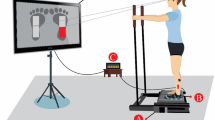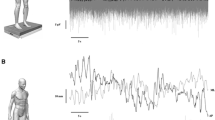Abstract
The repetition of muscle contractions is likely to generate fatigue which can provoke alterations of postural control. Regulatory mechanisms can be triggered to counteract these alterations. However, these mechanisms would occur only when fatigue is induced through voluntary (VOL) contractions and not with electrically stimulated (ES) contractions. Hence the aim was to compare the effects of VOL and ES fatiguing contractions inducing a similar level of strength loss on unipedal postural control (assessed by means of force platform and EMG measurements), maximal voluntary contraction (MVC) and central activation ratio (CAR) to characterize the alterations induced by both modalities of fatigue and the associated regulatory mechanisms. Results showed that the VOL exercise induced a significant decrease of the CAR whereas the ES exercise did not, thus illustrating that central fatigue was present only after voluntary contractions. The VOL exercise also induced greater postural disturbances and larger regulatory mechanisms than the ES exercise, which also induced postural regulatory mechanisms. The present study reveals that postural control mechanisms are modulated according to the nature of the fatiguing contractions, likely due integration of specific fatigue signals according to the modality of the contraction. Because of a larger neurophysiological impact of VOL than ES fatiguing contractions due to greater central disturbances, VOL exercise-induced larger regulatory mechanisms. Nevertheless, the presence of regulatory mechanisms with ES contractions clearly underlines the ability of the central nervous system to display an accurate motor control following acute externally induced neuromuscular perturbations.




Similar content being viewed by others
Change history
01 February 2019
In the metadata of the original publication of the article.
References
Bigland-Ritchie B, Woods JJ (1984) Changes in muscle contractile properties and neural control during human muscular fatigue. Muscle Nerve 7(9):691–699
Biomedical Health and Research Program (BIOMED II), SENIAM project (Surface ElectroMyography for the Non-Invasive Assessment of Muscles). http://www.seniam.org. Accessed Dec 2016
Bizid R, Margnes E, François Y, Jully JL, Gonzalez G, Dupui P, Paillard T (2009) Effects of knee and ankle muscle fatigue on postural control in the unipedal stance. Eur J Appl Physiol 106(3):375–380
Bonnard M, Sirin AV, Oddsson L, Thorstensson A (1994) Different strategies to compensate for the effects of fatigue revealed by neuromuscular adaptation processes in human. Neurosci Lett 166:101–105
Bord G (1990) Psychophysical scaling with applications in physical work and the perception of exertion. Scandinavian Journal of Work, Environment & Health: 55–58
Chaubet V, Paillard T (2012) Effects of unilateral knee extensor muscle fatigue induced by stimulated and voluntary contractions on postural control during bipedal stance. Clin Neurophysiol 42(6):377–383
Chaubet V, Cormery B, Maitre J, Paillard T (2013) Stimulated contractions delay and prolong central fatigue compared with voluntary contractions in men. J Strength Cond Res 27(5):1378–1383
Contessa P, Puleo A, De Luca CJ (2016) Is the notion of central fatigue based on a solid foundation? J Neurophysiol 115(2):967–977
Cut M, Wikstrom EA (2014) Learning effects associated with the least stable level of the Biodex® stability system during dual and single limb stance. J Sports Sci Med 13:387–392
Fauler M, Jurkat-Rott K, Lehmann-Horn F (2012) Membrane excitability and excitation-contraction uncoupling in muscle fatigue. Neuromuscul Disord 22(3):162–167
Fitts RH (2008) The cross-bridge cycle and skeletal muscle fatigue. J Appl Physiol 104(2):551–558
Froyd C, Beltrami FG, Millet GY, Noakes TD (2016) Central Regulation and Neuromuscular Fatigue during Exercise of Different Durations. Med Sci Sports Exerc 48(6):1024–1032
Gandevia SC (2001) Spinal and Supraspinal factors in human muscle fatigue. Physiol Reviews 81(4):1725–1789
García-Ramos A, Torrejón A, Feriche B, Morales-Artacho AJ, Pérez-Castilla A, Padial P, Jaric S (2018) Selective effects of different fatigue protocols on the function of upper body muscles assessed through the force-velocity relationship. Eur J Appl Physiol 118(2):439–447
Gribble PA, Hertel J (2004) Effect of hip and ankle muscle fatigue on unipedal postural control. J Electromyogr Kinesiol 14(6):641–646
Henneman E, Somjen G, Carpenter DO (1965) Functional significance of cell size in spinal motoneurons. J Neurophysiol 28:560–580
Hortobagyi T, Scott K, Lambert J, Hamilton G, Tracy J (1999) Cross-education of muscle strength is greater with stimulated than voluntary contractions. Mot Control 3:205–219
Huffenus AF, Forestier N (2006) Effects of fatigue of elbow extensor muscles voluntarily induced and induced by electromyostimulation on multi-joint movement organization. Neurosci Lett 403(1–2):109–113
Jones DA, De Ruiter CJ, De Haan A (2006) Change in contractile properties of human muscle in relationship to the loss of power and slowing of relaxation seen with fatigue. J Physiol 576(3):913–922
Kennedy A, Guevel A, Sveistrup H (2012) Impact of ankle muscle fatigue and recovery on the anticipatory postural adjustments to externally initiated perturbations in dynamic postural control. Exp Brain Res 223(4):553–562
Kent-Braun JA (1999) Central and peripheral contributions to muscle fatigue in humans during sustained maximal effort. J Appl Physiol 80:57–63
Kent-Braun JA, Le Blanc R (1996) Quantification of central activation failure during maximal voluntary contractions in humans. Muscle Nerve 19(7):861–869
Lexell J, Henriksson-Larsen K, Sjostrom M (1983) Distribution of different fibre types in human skeletal muscles. 2. A study of cross-sections of whole m. vastus lateralis. Acta Physiol Scand 117:115–122
Monjo F, Forestier N (2015) Electrically-induced muscle fatigue affects feedforward mechanisms of control. Clin Neurophysiol 126(8):1607–1616
Monjo F, Terrier R, Forestier N (2015) Muscle fatigue as an investigative tool in motor control: A review with new insights on internal models and posture-movement coordination. Hum Mov Sci 44:225–233
Noakes TD, St Clair Gibson A, Lambert EV (2005) From catastrophe to complexity: a novel model of integrative central neural regulation of effort and fatigue during exercise in humans: summary and conclusions. Br J Sports Med 39(2):120–124
Paillard T (2012) Effects of general and local fatigue on postural control: A review. Neurosci Biobehav Rev 36:162–176
Paillard T (2015) Complexity of the effects of the electrically-induced muscle fatigue on motor control. Clin Neurophysiol 126(8):1464–1465
Paillard T (2017) Relationship between muscle function, muscle typology and postural performance according to different postural conditions in young and older adults. Front Physiol 8:585
Paillard T (2018) Muscle plasticity of aged subjects in response to electrical stimulation training and inversion and/or limitation of the sarcopenic process. Ageing Res Rev 18:1568–1637
Paillard T, Noé F (2015) Techniques and methods for testing the postural function in healthy and pathological subjects. BioMed Res International, 2015:891390
Paillard T, Maitre J, Chaubet V, Borel L (2010a) Stimulated and voluntary fatiguing contractions of quadriceps femoris differently disturb postural control. Neurosci Lett 477:48–51
Paillard T, Chaubet V, Maitre J, Dumitrescu M, Borel L (2010b) Disturbance of contralateral unipedal postural control after stimulated and voluntary contractions of the ipsilateral limb. Neurosci Res 68:301–306
Paillard T, Margnes E, Maitre J, Chaubet V, François Y, Jully JL, Gonzalez G, Borel L (2010c) Electrical stimulation superimposed onto voluntary muscular contraction reduces deterioration of both postural control and quadriceps femoris muscle strength. Neuroscience 165:1471–1475
Paillard T, Lizin C, Rousseau M, Cebellan M (2014) Time to task failure influences the postural alteration more than the extent of muscles fatigued. Gait Posture 39:540–546
Ritzmann R, Freyler K, Werkhausen A, Gollhofer A (2016) Changes in Balance Strategy and Neuromuscular Control during a Fatiguing Balance Task-A Study in Perturbed Unilateral Stance. Front Hum Neurosci 10:289
Rothwell JC (2009) The fatigued spinal cord. J Physiol 587:5517–5518
Singh T, Latash ML (2011) Effects of muscle fatigue on multi-muscle synergies. Exp Brain Res 214:335–350
Taylor JL, Butler JE, Allen GM, Gandevia SC (1996) Changes in motor cortical excitability during human muscle fatigue. J Physiol 490:519–528
Taylor JL, Todd G, Gandevia SC (2006) Evidence for a supraspinal contribution to human muscle fatigue. Clin Exp Pharmacol Physio 33:400–405
Vanderthommen M, Duteil S, Wary C, Raynaud JS, Leroy-Willig A, Crielaard JM, Carlier PG (2003) A comparison of voluntary and electrically induced contractions by interleaved 1H- and 31P-NMRS in humans. J Appl Physiol 94:1012–1024
Veldman MP, Maffiuletti NA, Hallett M, Zijdewind I, Hortobágyi T (2014) Direct and crossed effects of somatosensory stimulation on neuronal excitability and motor performance in humans. Neurosci Biobehav Rev 47:22–35
Acknowledgements
The authors thank all the subjects for their cooperation.
Funding
This research did not receive any specific grant from funding agencies in the public, commercial, or not-for-profit sectors.
Author information
Authors and Affiliations
Corresponding author
Ethics declarations
Conflict of interest
The authors declare that they have no conflict of interest.
Ethical approval
All procedures performed in studies involving human participants were in accordance with the ethical standards of the institutional research committee and with the 1964 Helsinki declaration and its later amendments or comparable ethical standards.
Rights and permissions
About this article
Cite this article
Hachard, B., Noe, F., Catherine, A. et al. Voluntary and electrically-induced muscle fatigue differently affect postural control mechanisms in unipedal stance. Exp Brain Res 237, 313–323 (2019). https://doi.org/10.1007/s00221-018-5418-9
Received:
Accepted:
Published:
Issue Date:
DOI: https://doi.org/10.1007/s00221-018-5418-9




